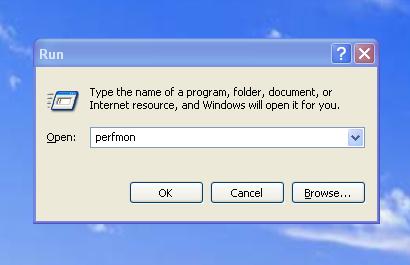

Top Tip: If you want to know which information (properties) are returned by a given functions, type: Function | get-member -membertype noteproperty. Before you get started, if you want to work with multiple servers, you need to enable the RemoteRegistry Service in the remote machines, as you can see :įigure 1.Ensuring the RemoteRegistry Service is active on the remote machines.įor further reading on why this is necessary, I suggest you take a look at “ Why run the RemoteRegistry Service?” by Brian Groth.

#Perfmon exe windows 7
Get-Help Get-PerfCounterCategory -examplesĪll tests were done on two Hyper-V 64-bit Virtual Machines a Windows 2008 Server R2 domain controller with SQL Server 2008 R2 (Obiwan), and a Windows 7 machine with SQL Server 2008 (Chewie). Alternatively, you can use the built-in help to see all of the parameters and some examples:
#Perfmon exe download
For now, you can download it from the top of this article, and I should point out that this module is a V1, so it might (and probably will) have some issues, and you can contact me anytime if you need a hand.

Performance CountersĪ polished version of this whole module will be available in the next release of SQLPSX – SQL Server PowerShell Extensions.
#Perfmon exe how to
Once we’ve covered that, we’ll take a look at how to get the data collected, and two ways to store it once we’ve got it. To start with, I’ll walk you through how to find out more information on the various Perfmon counters, so that you can choose which ones you want to use, as well as how to save that configuration so that you can reuse it later (and on different servers). This article will cover how to use this new module in a variety of situations, with some clear and every-day examples to hopefully make everything obvious. A special thank-you goes to MVP Pinal Dave ( Twitter| Blog), who invited me to be a guest blogger on, and MVP Grant Fritchey ( Twitter| Blog) for the kind words on his blog. As a result of my tinkering, I believe I’ve got something pretty useful to share with you.īefore I go on, I want to give a shout out to the people who helped me solve some issues I encountered as always, my friend MVP Shay Levy ( Twitter| Blog), and also MVP JVierra, Trevor Sullivan ( Twitter| Blog), and Lauri Kotilainen ( Twitter| Blog). I tried to think of an easy way to choose which counters you want, save this configuration for later use, and then insert the output data into a SQL Server table for further analysis. However, I need multiple counters, and the results displayed in line with all values separated by commas (which is usually used to facilitate insertion into SQL Server), and that’s when get-counter gets a little trickier to use. You may wonder to yourself, “ but you can do that with the get-counter cmdlet in PowerShell 2.0.“ I was reading an excellent article by Allen White ( Twitter| Blog) on Performance Data Gathering (to which I give all the credit for inspiring this module), and that’s when a PowerShell apple fell on my head: “ Why not make a function that facilitates this?” As a DBA, one of my almost-daily tasks is to capture and analyze Perfmon counters. Gathering Perfmon Data with Powershell - Simple Talk Skip to content


 0 kommentar(er)
0 kommentar(er)
